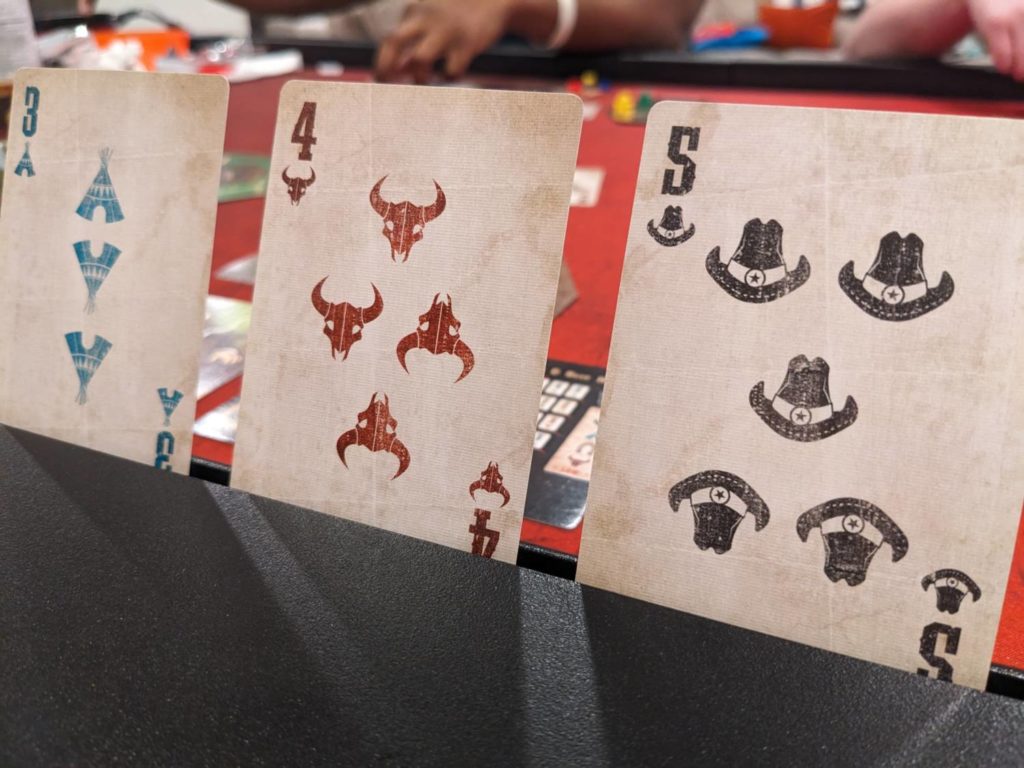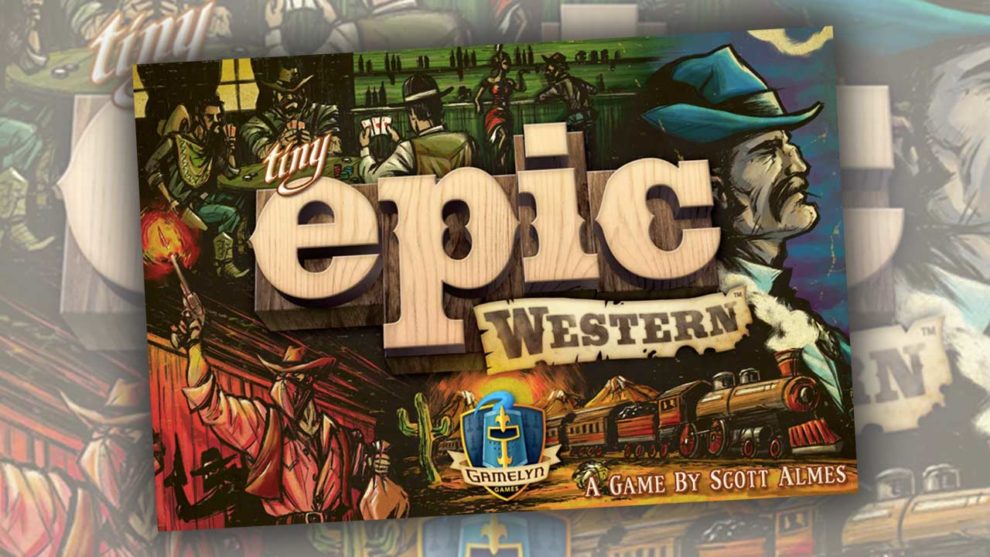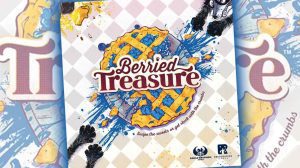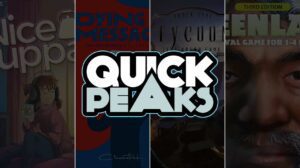Disclosure: Meeple Mountain received a free copy of this product in exchange for an honest, unbiased review. This review is not intended to be an endorsement.
I’ve had the chance to meet some of the team at Gamelyn Games at past conventions. I always stop and stare.
How do these guys keep coming up with so many strategy games that basically fit in a handbag?
I’ve had the chance to play Tiny Epic Galaxies and Tiny Epic Quest. Both games were fine; I would give Tiny Epic Galaxies the edge in terms of gameplay, and Tiny Epic Quest the edge in production because all of the tiny meeples can be outfitted with swords and shields. For a game that can be played on an average-sized kitchen counter, the amount of game in the box is a marvel for the Tiny Epic series. Prices are just as fair, with those games costing me about $25 each.
Our Meeple Mountain team is working with Gamelyn to go “back catalog” and review some of the older Tiny Epic games that we have not covered previously for the site. I signed on for Tiny Epic Mechs (a game that I bought personally) and Tiny Epic Western, a review copy sent by the publisher.
After getting a round of plays in summer, I admit that I align very closely with the game’s current ranking on BGG. It’s a fine time, with an easy teach and a serviceable solo mode so that you can get your Old West showdown time in while managing to squeeze out some interesting decisions over a 30-to-45 minute playtime.

Bullet Time
Tiny Epic Western is a 1-4 player worker placement game, with some elements of gambling thanks to a poker hand element that helps players plan between each of the six rounds. Taking on the role of a gang leader, players manage a “posse” of 2-3 posse meeples that can be placed on various spots around a six-location board that is arranged slightly differently in each game.
Turns are spread across four phases. First, players are dealt two poker cards, choosing one card to keep for that round. The cards range in value from 1-5, in one of the game’s four suits; the suits are ranked every game in the same order, from cowboy hats to teepees to horseshoes to cattle horns. That means that the 5 of cowboy hats is higher than the 5 of teepees, for example.
The card is important—it is used to determine a three-card poker hand based on the cards that are dealt in between each of the six locations. That means that at Town Hall, if there’s a 5 cowboy hat and a 5 teepees on either side of that location, holding a 5 of cattle horns will give you a 3 of a Kind when that location is resolved at a later time.
After cards are dealt, each player uses a turn to place one of their two posse members on a location. Tiny Epic Western has three main resources: money, law, and force, tracked on the bottom of each boss player mat. When players visit locations, they have a chance to either grab immediate resources (a small number of money, law and/or force) or wait until the end of the worker placement phase to compare poker hands with other players to see who has the winning hand, which nets a larger return on resources.

If a player wants to visit an occupied worker placement spot, they duel! Using some of the best six-sided dice I’ve ever seen—bullet dice!!—each player rolls one die to determine a winner, with defenders winning ties. Players can boost their roll by either re-rolling (spending a resource to do so) or revealing their previously-secret poker card and adding that value to their current roll. The loser suffers a wound to their posse member, which just means they are no longer eligible for the best rewards of a wait-and-see placement spot at that specific location at the end of the round.
During the resolution phase, all locations are decided based on poker hands. If a player has no one else to compete against at a location, a dummy card, known as the Rival’s Card, is used to compare against this instead.
Finally, players have the chance to buy one card in total at a location where they have a meeple. During setup, these cards are added one at a time to each location; when cards are bought, they are replaced for the next round. These cards also create new worker placement options in future rounds, because they are placed at the locations owned by the players currently in the game.
Location cards cost resources and range in value from 1-4 points, scored at the end of the game. In addition, each card has a series of tags aligned with three different “industry” icons. At the end of the game, the majority owner of each of the three industry tags will get a bonus on top of their building card scoring. A final bonus is granted to the current holder of the Wanted card, which is moved around based on whoever last won a duel.
Scores in my games ranged from the high teens to the mid 20s, so games of Tiny Epic Western are always close. But are those games interesting as well?

It’s Right on the Line
Tiny Epic Western’s BGG rating is a 6.6 as of this writing, and I was shocked how remarkably close I landed when considering the overall experience.
I love old west settings. I went out of my way on a recent road trip to visit Dodge City, Kansas, the real-world setting for the TV show Gunsmoke and a haven of fun country western activities for the family. Tombstone is my all-time favorite Western—my brother and I still make a point to quote the Val Kilmer character Doc Holliday every chance we can.
The game only captures a small amount of that Old West flair. I love the way location cards are drawn here (by artist Adam McIver) and the top-down view of town is a nice treat. The meeples and their cowboy hats, like the meeples from Great Western Trail, fit perfectly here. Those bullet dice are a dream come true, even if I seemed to roll a lot more 1s than 6s. Even the backs of the poker cards and the building cards feel a bit dusty, like they were made intentionally dirty before the game was sent over.
Competition in the Old West, though, is not high enough, at least at lower player counts. At four players, I thought Tiny Epic Western was very interesting, and almost always leads to more duels. In the solo and two player variants, you will typically be able to go where you want, and if you have a great hand, you can always rest assured that your meeples will win out if it comes down to that between a rival.
Even with great planning, die rolls are too consequential in Tiny Epic Western. I was surprised how often I planned around my poker hand, in some cases picking a high card just to make sure I could add that to my roll, only to find myself hosed by a roll of a one or a two then adding my poker hand only to remain short of my opponent. (You can spend resources to re-roll, but that makes buying a building card at the end of each round very difficult.)
Tiny Epic Western, then, is a bit tricky. Many of you are strategy gamers who hear the term “worker placement” and assume you can count on the result. In this game, luck is a major factor; the poker hand is a hint, right? We also found times where the flop of new building cards coming into play happened to fit well with a player who happened to have all of the things they needed to buy it even before the round began…and those same cards sometimes were worth three or four points, instead of the lower point values.
How about that all-important fun factor? I like press-your-luck in games, and Tiny Epic Western certainly has that. The game doesn’t overstay its welcome, because in most rounds a player will only have two worker placement actions and little, if any, dueling in a lower player-count game. The Boss cards look like they have a ton of variety, but the player powers are muted. The game allows for both a draft or a random selection of these cards, but I would let players see all of their choices first then draft. That way, they can at least lean into the power to maximize its effect.
For example, the Bounty Hunter, Gunslinger, and Lawman all pay off only if you are dueling other players. In a two-player game with my wife (where she avoids competition like the plague), I would skip using any of those cards and focus on powers that boost resource collection for buying buildings.
Tiny Epic Western isn’t bad, but it wasn’t as strong to me as either of my previous Tiny Epic experiences. Designer Scott Almes knows how to make interesting work come to the table in a tidy package, but this is a Western I would rent before buying.











